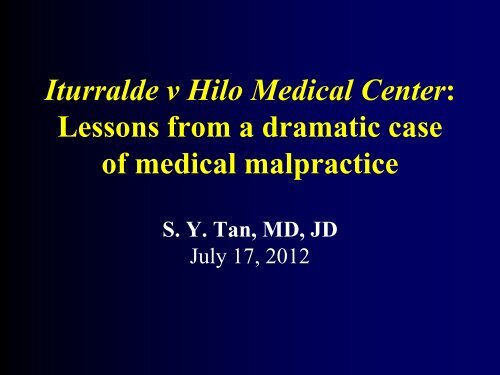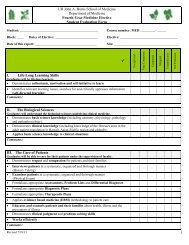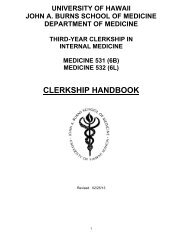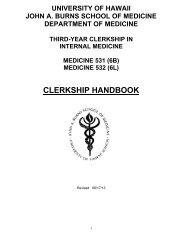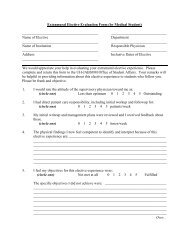Iturralde v Hilo Medical Center
Iturralde v Hilo Medical Center
Iturralde v Hilo Medical Center
- No tags were found...
You also want an ePaper? Increase the reach of your titles
YUMPU automatically turns print PDFs into web optimized ePapers that Google loves.
<strong>Iturralde</strong> v <strong>Hilo</strong> <strong>Medical</strong> <strong>Center</strong>:Lessons from a dramatic caseof medical malpracticeS. Y. Tan, MD, JDJuly 17, 2012
<strong>Iturralde</strong> v <strong>Hilo</strong> <strong>Medical</strong> <strong>Center</strong>(Intermediate Court of Appeals of Hawaii#28792, March 30, 2012)• Arturo <strong>Iturralde</strong>• Dr. Robert Ricketson• <strong>Hilo</strong> <strong>Medical</strong> <strong>Center</strong>• Medtronic• Rosalinda <strong>Iturralde</strong>• Hawaii Orthopedics• State of Hawaii• Nurse Janelle Feldmeyer
Legal Issues• <strong>Medical</strong> Malpractice• Negligent Credentialing (Non-delegable duty)• Joint/Several Liability• Vicarious Liability• Damages (Exemplary damages)• Negligent Infliction of Emotional Distress (NIED)• Products Liability (Defect; superseding cause)
Elements of Malpractice• Duty• Breach of Duty (Standard of Care)• Factual and Legal Causation• Damages
Standard of Care• Defined in Prosser’s Textbook on Torts:“The formula under which this usually isput to the jury is that the doctor must haveand use the knowledge, skill and careordinarily possessed and employed bymembers of the profession in goodstanding...”
Joint & Several Liability• If more than one defendant has concurrently orsuccessively caused a plaintiff’s indivisibleinjury, the victim can recover all damagesfrom any of the tortfeasors irrespective ofdegree of fault, so long as causation is proven.• However, the plaintiff is not entitled to doublerecovery, and the defendant can proceedagainst the other liable parties who jointlycaused the injury for contribution.
Vicarious Liability• Vicarious liability, typically applicable in anemployer-employee situation, is that liabilityimputed to an employer, but which arose fromthe tortious action of the employee.• For vicarious liability to arise, the employee’sact must have occurred during and within thescope of employment, and the risk of harmforeseeable.
Respondeat Superior• Respondeat superior or “let the master answer” isthe legal doctrine underpinning vicarious liability.• Idea behind this rule is to ensure that theemployer, as supervisor, will enforce proper workstandards to avoid risk of harm.• Employer is also better able to shoulder the costof compensating the victim or insure againstwork-place injuries.
Vicarious Liability (cont’d)• Hospitals and clinics can be vicariously liable fornegligence of their staff, although they can alsoincur direct liability, e.g., negligent maintenance ofpremises, or breach of non-delegable duty such ashiring and credentialing of medical staff.• Vicarious liability in the healthcare context istypically seen in hospital/employee, hospital/doctor,or doctor/employee relationships. Where doctorsare employees of public hospitals, their negligencewill be imputed to the hospital, which in turnbecomes vicariously liable to the injured plaintiff.
Non-Delegable Duties• Sometimes duties owed by the institution orcompany are so integral to its function thatcourts have deemed such duties non-delegable.• At common law, dangers created on a highwayor extra hazardous activities have been deemednon-delegable duties.• Non-delegable duties can also arise by statute,e.g., workplace safety.
Damages• Compensatory Damages– General Damages– Special Damages• Exemplary Damages
Negligent Infliction ofEmotional Distress (NIED)• At common law, no recovery for psychiatricharm or nervous shock (known as NIED in theU.S.), for fear of opening litigation floodgatesto endless claims of psychiatric injury.• Over time, increasing judicial recognition of theplaintiff who witnessed sudden and oftentimeshorrific injuries of a loved one at an accidentscene, and then suffered severe psychiatricharm as a result.
Gloria Ochoa v Superior Court ofSanta Clara County39 Cal. 3d 159 (1985)• Defendant’s negligent Dx/Rx of 13-year-old juveniledetainee led to the boy’s death following high fever,delirium, convulsions, vomiting, and coughing of blood.• Events unfolded in front of mother whose pleas overdays for prompt medical attention went unheeded.• Court ruled for plaintiff-mother on her fully foreseeableclaim of emotional distress, her suffering having beenbrought about through her sensory perception ofdefendant’s conduct and her son’s illness.
Dillon Test• Many jurisdictions have adopted so-calledCalifornia or Dillon test (Dillon v Legg, 441 P. 2d912, Cal. 1968) which focuses on bystanderforeseeability and satisfying three“proximities”:– 1) physical proximity, i.e., bystander is located atthe scene,– 2) temporal proximity, i.e., claimant personallyobserves the accident at the time it happened, and– 3) relational proximity (bystander’s closerelationship to primary victim).
NIED in Hawaii• Hawai‘i Supreme Court rejected the“physical injury” rule requiring NIEDplaintiffs to demonstrate some level ofphysical injury (Rodrigues v. State, 52 Haw.156 at 173).• It thereby recognized mental distress as “alegally cognizable injury.” (Larsen v.Pacesetter Sys., Inc., 74 Haw. 1 at 42–43).
Products Liability• Liability of Medtronic for failing to deliverthe titanium rods?• Was the product defective?• Was Dr. Ricketson’s action a supersedingcause (Novus actus interveniens)?
Acoba v. Gen. Tire, Inc.,986 P.2d 288 (1999)• To establish a prima facie claim for strictproduct liability, the plaintiff has the burdento prove:– (1) a defect in the product which rendered itunreasonably dangerous for its intended orreasonably foreseeable use; and– (2) a causal connection between the defect andthe plaintiff's injuries.
Stewart v. Budget Rent–A–Car470 P.2d 240 (1970)• [O]ne who sells or leases a defective productwhich is dangerous to the user or consumer orto his property is subject to liability forphysical harm caused by the defective productto the ultimate user or consumer, or to hisproperty, if (a) the seller or lessor is engaged inthe business of selling or leasing such product,and (b) the product is expected to and doesreach the user or consumer without substantialchange in its condition after it is sold or leased.
Superseding Cause• A superseding cause severs original tortfeasor'sliability.• Whether a subsequent cause constitutessuperseding cause is factual question that turnson foreseeability.• Subsequent cause of injury, includingnegligence of a third party, is not supersedingcause if reasonably foreseeable.• Only in an “extraordinary” case will interveningnegligence constitute a superseding cause.
Knodle v. Waikiki Gateway Hotel69 Haw. 376 (1987)• A guest was murdered at the WaikikiGateway Hotel.• Victim’s father sued the hotel on anegligence theory.• Supreme court held that the juryinstructions regarding superseding causewere defective.
Knodle (cont’d)• Court found error in instruction concerningforeseeability, which read: “An act is reasonablyforeseeable if it appears to have been ordinary orusual under all the circumstances then existing.”• Court noted: We fail to see how murder can be‘ordinary or usual’ under any circumstance. Wecould say the same about lightning striking at anygiven place or time; yet since ‘the possibility isthere, it may require precautions for theprotection of inflammables.’
Knodle (cont’d)• Supreme court concluded that trial court erredin employing the “ordinary or usual” language.• Test for reasonable foreseeability is not“whether the act or risk appears to have beenordinary or usual under all the circumstances”.• Instead, appropriate standard is whether “thereis some probability of harm sufficiently seriousthat a reasonable and prudent person wouldtake precautions to avoid it.”
<strong>Iturralde</strong>’s case• Circuit Court's instruction “If the act was a normalconsequence of the situation created by defendant'sconduct, then said act is not a superseding cause.”• This suggests that if subsequent act is not whatreasonable person would consider to be a “normalconsequence” created by defendant's conduct, thensaid intervening act is superseding cause.• Thus, it wholly fails to convey relevant standard—whether probability of harm is “sufficiently seriousthat a reasonable and prudent person would takeprecautions to avoid it.”
<strong>Iturralde</strong> (cont’d)• The “normal consequence” language improperly tippedthe scales in favor of the conclusion that Dr. Ricketson'snegligence was not foreseeable.• A reasonable person would be hard-pressed to considera surgeon's improvised act of implanting a sawed-offscrewdriver into a patient's spine to be a “normalconsequence” of Medtronic's (alleged) failure to shipthe rods.• Under correct standard enunciated in Knodle, however,jury might have reached different conclusion.
Legal Issues• <strong>Medical</strong> Negligence• Negligent Credentialing (Non-delegable duty)• Joint/Several Liability• Vicarious Liability• Damages (Exemplary damages)• Negligent Infliction of Emotional Distress• Products Liability (Defect, superseding cause)


